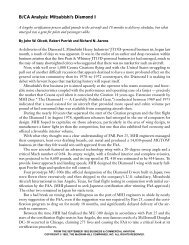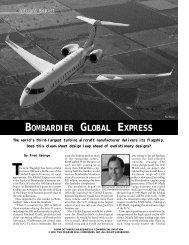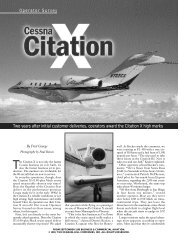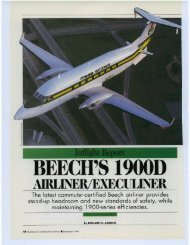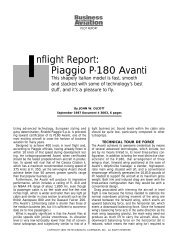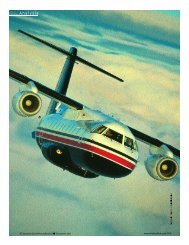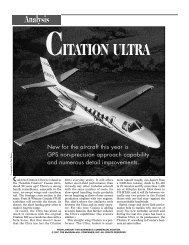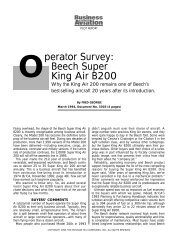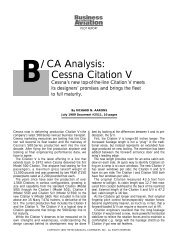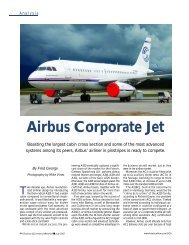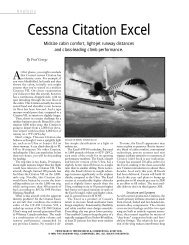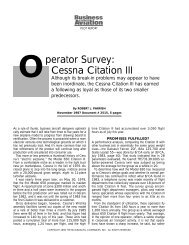Challenger 604
Challenger 604
Challenger 604
You also want an ePaper? Increase the reach of your titles
YUMPU automatically turns print PDFs into web optimized ePapers that Google loves.
Analysis<br />
By FRED GEORGE<br />
CHALLENGER <strong>604</strong><br />
The fourth-generation <strong>Challenger</strong> blends 4,000-mile<br />
maximum range with bread-and-butter utility and<br />
top-ranked product support.<br />
FROM SEPTEMBER 1995 BUSINESS & COMMERCIAL AVIATION.<br />
© 1995, THE McGRAW-HILL COMPANIES, INC. ALL RIGHTS RESERVED.
Flight-test personnel waste no time preparing the <strong>Challenger</strong> <strong>604</strong> prototype (serial<br />
number 5991) for the next flight in the series. The flight is needed in order to<br />
complete development work in time for December certification. Winglets effectively<br />
increase the span while not significantly increasing wing loading. Even with the yaw<br />
damper turned off, the aircraft at normal cruise speed exhibits positive stability in the<br />
coupled yaw/roll mode.<br />
The large, double-slotted,<br />
trailing-edge fowler flaps are<br />
quite effective, but leadingedge<br />
devices might help to<br />
reduce the V-speeds, in light<br />
of the <strong>Challenger</strong> <strong>604</strong>’s<br />
relatively high wing loading.<br />
The rudder pedals provide +/-7.5 degrees<br />
of nosewheel steering. The large NWS<br />
tiller provides +/-55 degrees authority<br />
and has excellent tactile feel.<br />
F<br />
riday, June 10 marked a watershed<br />
event in the history of the Canadair<br />
<strong>Challenger</strong>. A conforming<br />
prototype<br />
of the new Model<br />
<strong>604</strong>, with a B/CA<br />
editor on board,<br />
flew nonstop from<br />
Wichita Mid-Continent<br />
Airport to<br />
Paris’ Le Bourget—a<br />
distance of<br />
4,242 nm over the<br />
Earth, or 4,011<br />
miles equivalent<br />
still air distance,<br />
accounting for the<br />
winds aloft. This<br />
was the longest<br />
distance ever flown<br />
by a Canadair<br />
<strong>Challenger</strong>.<br />
The Wichita-to-Paris flight proved<br />
that the new flagship of the <strong>Challenger</strong><br />
family could deliver 400 miles<br />
more range than the 601-3R at a longrange<br />
cruise speed of 424 knots. The<br />
<strong>604</strong> also set a Federation Aeronautique<br />
Internationale (FAI) range<br />
record for Class C-1j—for aircraft with<br />
a takeoff weight of 44,092 to 55,115<br />
pounds. More importantly to business<br />
aircraft operators, Canadair lived up<br />
to its promise to build a <strong>Challenger</strong><br />
with 4,000-nm legs.<br />
As a result, <strong>Challenger</strong> <strong>604</strong> operators<br />
won’t have to stop for fuel when<br />
flying from Europe to North America.<br />
Notably, westbound transatlantic<br />
trips—almost without exception—can<br />
be flown at 0.80 Mach because of the<br />
aircraft’s 3,750-mile range at the 459-<br />
knot normal cruise speed.<br />
The <strong>Challenger</strong> <strong>604</strong>, thus, closes<br />
much of the maximum range gap<br />
between itself and the Dassault Falcon<br />
900B and Gulfstream IVSP—but not<br />
at an apples-to-apples 0.80 Mach. Carrying<br />
the same payload, those two<br />
competitors still have slightly greater<br />
range at 459 KTAS.<br />
Although its cabin is larger in cross<br />
section than any of its direct competitors,<br />
the <strong>Challenger</strong> <strong>604</strong> interior has<br />
less volume due to its shorter usable<br />
length.<br />
On shorter, transcontinental missions,<br />
the Falcon 2000 is the <strong>604</strong>’s<br />
main competitor because it can carry a<br />
1,600-pound payload 3,000 miles with<br />
a cruise speed of 459 knots. The <strong>Challenger</strong><br />
<strong>604</strong>, flying at the same speed,<br />
has a 20-percent range advantage with<br />
Paul Bowen Photography (5))<br />
FROM SEPTEMBER 1995 BUSINESS & COMMERCIAL AVIATION.<br />
© 1995, THE McGRAW-HILL COMPANIES, INC. ALL RIGHTS RESERVED.
ANALYSIS<br />
eight passengers on board, but it’s<br />
largely overkill for coast to coast trips.<br />
That’s okay with John Lawson,<br />
president of Bombardier’s Business<br />
Aircraft Division. He claims that the<br />
<strong>Challenger</strong> <strong>604</strong> wins hands down<br />
against the heavy-iron business jets, if<br />
acquisition and operating cost also are<br />
thrown into the comparison. Lawson<br />
also claims the Falcon 2000 is only 10-<br />
percent less expensive when equipped<br />
for transoceanic missions, that it has<br />
to stop en route for fuel when facing<br />
headwinds on westbound transatlantic<br />
trips, plus it actually costs more to<br />
operate than a <strong>604</strong>. Last year’s sales<br />
figures add credibility to Lawson’s<br />
viewpoint. In 1994, Canadair delivered<br />
25 <strong>Challenger</strong>s, topping the sales of<br />
the Falcon 900, the Falcon 2000 or<br />
Gulfstream IV.<br />
RANGE VERSUS PAYLOAD<br />
The <strong>Challenger</strong> <strong>604</strong> almost begs business<br />
aircraft operators to study the<br />
performance charts. Look how tightly<br />
grouped the payload lines are on the<br />
Range/Payload Profile. Then glance at<br />
the Specific Range chart and the Time<br />
and Fuel Versus Distance chart. Bombardier’s<br />
Business Aircraft Division<br />
quotes a maximum range of 4,000 nm<br />
with five passengers for the <strong>Challenger</strong><br />
<strong>604</strong>, but with eight people in<br />
back, the maximum range is still 3,850<br />
miles at long-range cruise. (Bombardier<br />
claims that long-range cruise<br />
is 0.74 Mach. In contrast, we flew a<br />
constant angle of attack, decreasing<br />
Mach profile between Wichita and<br />
Paris, with speeds ranging from 0.73<br />
Mach and 0.71.)<br />
Loading the aircraft with three more<br />
passengers—eight instead of five—<br />
results in a comparative decrease in<br />
Paul Bowen Photography (2)<br />
<strong>Challenger</strong> <strong>604</strong><br />
pilots will experience<br />
the most<br />
advanced avionics<br />
suite ever installed<br />
in a Bombardier<br />
business aircraft.<br />
That becomes obvious<br />
as soon as one<br />
enters the cockpit.<br />
Six Collins Pro<br />
Line 4 7.25-inch<br />
CRTs—two primary<br />
flight displays<br />
(PFDs), two multifunction<br />
displays<br />
(MFDs) and two<br />
engine instruments<br />
and crew advisory<br />
systems (EICASes)—occupy<br />
a large<br />
portion of the <strong>Challenger</strong><br />
<strong>604</strong>’s instrument<br />
panel. The<br />
forward section of the triple-wide<br />
center console houses the FMS control<br />
display units. The only conventional<br />
“steam gauges” are three<br />
standby air-data instruments and a<br />
wet compass.<br />
The control panel for the dualchannel,<br />
digital flight control system<br />
panel is located up in the<br />
glareshield, where both pilots have<br />
unrestricted access to it. Notably,<br />
the mode-control buttons have adjacent<br />
annunciator lights that greatly<br />
enhance hand-eye coordination during<br />
mode selection. Mode annunciations<br />
also are displayed on the EFIS<br />
screens.<br />
Just aft of the power control<br />
COLLINS PRO LINE 4 AVIONICS<br />
levers, left- and right-side radio tuning<br />
units that control the<br />
comm/nav/surveillance radios<br />
bracket a central EICAS control<br />
panel. The rear section of the console<br />
houses the air-data computer,<br />
weather radar, IRS and other system<br />
control panels.<br />
The density of control functions<br />
in the center console requires that<br />
pilots spend some time learning<br />
where each control function is located<br />
and how each control works.<br />
Pilots new to the <strong>604</strong> should plan on<br />
spending plenty of familiarization<br />
time in a cockpit-procedures trainer<br />
prior to belting into the simulator,<br />
and beyond that, the actual aircraft.<br />
Performance features<br />
of the standard<br />
avionics<br />
package are indeed<br />
impressive, and the<br />
reliability of the<br />
hub-and-spoke<br />
architecture Collins<br />
Pro Line 4 system<br />
has been thoroughly<br />
demonstrated on the<br />
Canadair RJ, as well<br />
as several other aircraft,<br />
prior to making<br />
its debut on a<br />
<strong>Challenger</strong>. A dualchannel,<br />
integrated<br />
avionics processing<br />
system (IAPS) box<br />
forms the hub of the<br />
system with various<br />
sensors, controls and<br />
radios linked by<br />
ARINC 429 spokes.<br />
The IAPS contains dual digital<br />
flight-control systems, each with its<br />
own yaw damper, autopilot and<br />
flight-director computer; dual FMS<br />
cards (with provisions for a third<br />
FMS); and a sophisticated maintenance<br />
diagnostic computer that will<br />
monitor and record data from several<br />
aircraft systems outside the<br />
avionics suite—including the<br />
engines.<br />
Included in the avionics package<br />
are dual Litton Flagship IRS, dual<br />
all-digital interface Pro Line 4<br />
comm/nav/surveillance and HF<br />
radios, dual digital air-data computers,<br />
and dual-data concentrator<br />
units that listen to inputs from sev-<br />
FROM SEPTEMBER 1995 BUSINESS & COMMERCIAL AVIATION.<br />
© 1995, THE McGRAW-HILL COMPANIES, INC. ALL RIGHTS RESERVED.
ange. Carrying a 1,600-pound payload,<br />
the <strong>604</strong> can fly 3,747 nm at longrange<br />
cruise and 3,600 nm at 0.80<br />
Mach.<br />
Every aircraft design, however,<br />
requires tradeoffs. Glance, for a<br />
moment, at the accompanying specifications<br />
box. The <strong>Challenger</strong> <strong>604</strong> has<br />
the highest wing loading of any current-production<br />
general-aviation aircraft<br />
designed for business use. The<br />
wing has trailing-edge, double-slotted<br />
fowler flaps, but no leading edge<br />
devices.<br />
Then, consider the lack of leading<br />
edge devices and high wing loading,<br />
coupled with the relatively large<br />
thrust lapse rate of the high-bypassratio<br />
General Electric CF34 turbofans.<br />
The result is predictable—especially<br />
when departing from hot-and-high airports.<br />
The <strong>604</strong> has a longer takeoff<br />
field length than any of its competitors<br />
have, when all are loaded to MTOW.<br />
But, the charts also point out the<br />
<strong>604</strong>’s operating flexibility. Head to<br />
head with a Falcon 2000, the <strong>604</strong><br />
needs less runway when departing on<br />
a 3,000-mile trip that will be flown at<br />
0.80 Mach with eight passengers.<br />
Another one of the <strong>Challenger</strong> <strong>604</strong>’s<br />
strong suits is better density altitude<br />
performance, compared to the <strong>Challenger</strong><br />
601-3R. The <strong>604</strong>’s -3B engines<br />
are flat-rated at 8,729 pounds-thrust<br />
for takeoff (9,220 pounds APR) to<br />
ISA+30°C, compared to ISA+8°C for<br />
the 601-3R’s -3A1 turbofans. The<br />
improvement comes through loud and<br />
clear when departing from hot and<br />
high airports. The <strong>Challenger</strong> <strong>604</strong>,<br />
loaded to a maximum 47,600-pound<br />
takeoff weight, needs 9,430 feet of runway<br />
when departing from a 5,000-foot<br />
elevation airport at 25°C (77°F). That’s<br />
eral kinds of sensors and then digitize<br />
the data into ARINC 429 format<br />
for digestion by the IAPS. A<br />
TWR-850 Doppler turbulencedetection<br />
weather radar and a<br />
radio altimeter also are part of the<br />
package.<br />
The biggest change in the <strong>Challenger</strong><br />
<strong>604</strong>’s cockpit won’t become<br />
apparent until power is applied to<br />
the system. It’s the dual Collins<br />
AVSAT 6000 FMS equipped with<br />
dual 12-channel, GPS 4000 satellite<br />
navigation receivers. Quite candidly,<br />
in our opinion, this FMS rivals<br />
the best systems we yet have seen<br />
in business aircraft. Although many<br />
of the features are still under development<br />
until late October, the<br />
AVSAT 6000 tangibly proves that<br />
Collins intends to be a top-ranked<br />
competitor in FMS.<br />
The AVSAT 6000 is being developed<br />
as a takeoff-to-touchdown system,<br />
but it will be a climb-cruisedescent-approach<br />
system in the<br />
<strong>Challenger</strong> <strong>604</strong> because autothrottles<br />
currently aren’t offered as standard<br />
or optional equipment.<br />
In addition, the performancemanagement<br />
function of the<br />
AVSAT 6000 virtually will store all<br />
of the aircraft flight manual and<br />
cruise performance numbers for the<br />
<strong>604</strong>. The FMS will compute the<br />
takeoff N1 rpm setting and then<br />
display N1 target bugs on the<br />
tachometer displays on the EICAS.<br />
It also will compute the takeoff field<br />
distance, climb performance and<br />
top-of-climb point, cruise performance<br />
and step-climb point, top-ofdescent<br />
point and level-off point.<br />
The system will feature complete<br />
The quiet, dark design of the cockpit is<br />
reflected in the overhead panel, which<br />
has systems diagrams on the control<br />
panels.<br />
multiple waypoint lateral and vertical<br />
navigation guidance, including<br />
all ARINC 424 procedure legs necessary<br />
to all SIDs and STARs; an<br />
automatic FMS-to-NAV hand-off for<br />
seamless long-range-nav-to-ILS<br />
transitions; GPS non-precision<br />
approaches; and full, multiple waypoint<br />
vertical navigation with pointto-point<br />
gradient computations.<br />
Designed as a “smart box,” the<br />
AVSAT 6000 will alert the crew if<br />
the aircraft’s performance—climbing<br />
or descending—won’t be adequate<br />
to comply with either a<br />
published or a programmed procedure.<br />
When flying a STAR from a<br />
close-in high-altitude initial descent<br />
point, for example, the pilot will be<br />
warned by the system if the aircraft<br />
won’t make an altitude crossing<br />
restriction because of a VMO, published<br />
STAR airspeed requirement<br />
or 250-KIAS federal speed-limit<br />
constraint. The pilot, thus alerted<br />
by the FMS, could then change<br />
power setting, extend the spoilers or<br />
configure the aircraft to comply<br />
with the performance requirement.<br />
Fuel calculations will be based on<br />
flight-manual performance, realtime<br />
fuel flows or a combination of<br />
both. No longer, for example, will<br />
pilots watch the FMS predict flameout<br />
half way to the destination during<br />
climb-out because the system is<br />
looking at instantaneous fuel flows<br />
rather than at the predicted fuel<br />
burn for the entire profile.<br />
The AVSAT 6000 also will<br />
retrieve winds and temperature<br />
aloft forecasts from an optional airfield<br />
flight information service<br />
(AFIS) datalink, and will plug the<br />
data into the flight plan to update<br />
the performance predictions. An<br />
alternate flight-plan feature will<br />
allow pilots to ask the system to<br />
compute “what-if” performance<br />
changes based on speed, altitude or<br />
route variations.<br />
The standard, but previously<br />
optional, GPS 4000 satnav receivers<br />
will be certified for non-precision<br />
approach. Collins is developing an<br />
APR 4000 follow-on box, slated for<br />
certification at the end of 1996, that<br />
will be capable of both wide-areadifferential<br />
and local-area-differential<br />
GPS navigation that will enable<br />
the system to provide GPS precision-approach<br />
guidance.<br />
<strong>Challenger</strong> <strong>604</strong> avionics options<br />
include TCAS, GPWS, a third Litton<br />
IRS, third FMS card, third data<br />
concentrator unit (two are required<br />
for dispatch), BFGoodrich lightning<br />
detection system, split-scan radar<br />
control, a third VHF comm for<br />
clearance delivery and a second<br />
radio altimeter—and a Collins satcom<br />
system with up to six channels.<br />
FROM SEPTEMBER 1995 BUSINESS & COMMERCIAL AVIATION.<br />
© 1995, THE McGRAW-HILL COMPANIES, INC. ALL RIGHTS RESERVED.
Paul Brou<br />
1,664 feet less runway than needed by<br />
the <strong>Challenger</strong> 601-3R departing<br />
under the same conditions at its<br />
45,100-pound MTOW—2,500 pounds<br />
less weight.<br />
SPEED AND ALTITUDE<br />
CAPABILITY<br />
The CF34-3B engines are indeed fuel<br />
miserly because of their high bypass<br />
ratio. The tradeoff is a relatively high<br />
FROM THE TOP<br />
“Value for money” is John Lawson’s operating<br />
philosophy at Bombardier’s Canadair division.<br />
The president of Bombardier’s Business Aircraft<br />
Division claims that’s why, “We continue<br />
to be the primary supplier of airplanes in the<br />
large category.”<br />
And the tangible results are being passed on<br />
to <strong>Challenger</strong> <strong>604</strong> buyers. Two years ago,<br />
Canadair estimated the price of a completed<br />
<strong>604</strong> to be $20 million in 1993 dollars. Now it<br />
has increased only to $20.5 million.<br />
Bombardier is attacking operating costs just<br />
as aggressively, Lawson explained. “One of the<br />
real advantages of the <strong>604</strong> goes back to the<br />
flow-through effect of our airline experience<br />
with the Regional Jet. We’re going to a taskoriented<br />
maintenance program on the engines,<br />
resulting in a 10- to 12-percent reduction in the<br />
overall operating expense. Our airplane actually is less expensive to operate<br />
than the Falcon 2000.”<br />
Product support is another strong point of the <strong>Challenger</strong> program.<br />
Lawson claims that the firm’s product support has scored “unequivocal<br />
number one” in five operator surveys during the last four years. “Without<br />
question, this is a strong point, and that didn’t happen by accident. I think<br />
we have been the industry leader in terms of innovative programs like<br />
SmartParts, customer account managers and action centers. Customer<br />
service and product support are preoccupations with us.”<br />
Optimizing cost control and product support aren’t Bombardier’s only<br />
goals, however. <strong>Challenger</strong> operators told Bombardier that they wanted<br />
more range than what is offered by the <strong>Challenger</strong> 601. “We’re going to<br />
meet or exceed the goal of delivering a 4,000-mile-range aircraft. Without<br />
a doubt, that’s why we’re bringing this aircraft to market. And all of our<br />
flight-test data confirm the predicted performance parameters.”<br />
The maximum range is available when flying at 0.70 to 0.74 IMN,<br />
depending on aircraft weight—a speed that hardly sets any records in the<br />
heavy-iron class. Lawson commented, “When you need 4,000 miles—the<br />
full extent of the aircraft’s range—we’re prepared to fly at LRC [longrange<br />
cruise]. We’ll compromise and fly at this lower speed, given the difference<br />
in acquisition cost between the 900B and G-IVSP.<br />
Percentage-wise, the number of 4,000-mile missions we do is quite small.<br />
Once you get down into the normal, day-to-day, bread-and-butter missions,<br />
we can do them at 0.80 Mach or 0.83.”<br />
What’s the primary market for the <strong>Challenger</strong> <strong>604</strong>? “We’ve positioned<br />
the aircraft very carefully,” Lawson said. “Our focus has been on the family<br />
of Bombardier aircraft. The 4,000-mile <strong>Challenger</strong> <strong>604</strong> fits very nicely<br />
between the Learjet 60 and the Global Express. It competes effectively<br />
both up and down the spectrum of competitors. It has the widebody cabin,<br />
which has always been the hallmark of the <strong>Challenger</strong>. It competes<br />
upward against the Dassault 900 and the Gulfstream G-IV [because] we’ve<br />
managed to maintain a significant price differential between the airplanes,<br />
concentrating on the ‘value for money’ image that we’ve cultivated.”<br />
thrust-lapse rate—the inverse change<br />
of thrust output with altitude<br />
increase.<br />
Improvement in the -3B engine’s<br />
specific fuel consumption, compared to<br />
the -3A1, pays a dividend in increased<br />
range when departing from shorter<br />
runways. The <strong>Challenger</strong> <strong>604</strong> can fly<br />
800 nm farther than a 601-3R when<br />
departing from a 3,400-foot, sea-level<br />
runway.<br />
ANALYSIS<br />
However, the thrust-lapse rate<br />
becomes apparent on climb-out. The<br />
<strong>604</strong>’s service ceiling is 37,700 feet on a<br />
standard day—markedly lower than<br />
aircraft to which the <strong>Challenger</strong> is frequently<br />
compared.<br />
The CF34 has a relatively low highaltitude,<br />
thrust-to-weight ratio compared<br />
to many other turbofan engines.<br />
Although we have no engine thrust<br />
output data for the <strong>604</strong> at 37,700 feet,<br />
Bombardier told B/CA that the CF34-<br />
3B produces 1,450 pounds-thrust at<br />
0.74 Mach at 41,000 feet—one-sixth of<br />
its takeoff-rated thrust.<br />
For example, compare the -3B<br />
engine’s high-altitude thrust to the<br />
output of the CFE738 that is fitted to<br />
the considerably lighter weight Falcon<br />
2000. The CFE738 is rated at 5,725<br />
pounds of takeoff thrust, and its<br />
thrust output at 0.80 Mach at 40,000<br />
feet on a standard day is 1,468<br />
pounds—more than one-fourth of the<br />
takeoff rated thrust.<br />
The differences in the altitude and<br />
Mach number at which the two<br />
engines are measured means that our<br />
comparison is not strictly apples-toapples.<br />
It’s more like Macintoshes to<br />
Granny Smiths, but the <strong>Challenger</strong><br />
<strong>604</strong> still has a markedly lower thrustto-weight<br />
ratio than the Falcon 2000<br />
at high altitude, resulting in a lower<br />
initial cruise altitude.<br />
Similarly, the Falcon 900B, 900EX<br />
and Gulfstream IV have better highaltitude,<br />
thrust-to-weight ratios than<br />
the <strong>604</strong>. As a result, those aircraft<br />
each have a higher service ceiling.<br />
Paper comparisons aside, the <strong>604</strong><br />
has no problem climbing to an initial<br />
cruise altitude in the high thirties,<br />
even on warm days. The rate of climb<br />
noticeably slows down above FL 300,<br />
based on our observations, but still it<br />
climbed directly to FL 370 in 29 minutes<br />
on our flight from Wichita to<br />
Paris, including an intermediate leveloff<br />
at FL 330 for ATC and in spite of<br />
ISA+4°C to +12°C temperatures.<br />
That’s 2,000 to 4,000 feet higher than<br />
the CL 601-3R operating in similar<br />
conditions—but the <strong>604</strong> seldom will<br />
climb out of the rigid routing of the<br />
published ICAO North Atlantic organized<br />
tracks in either direction.<br />
The engine performance is well-suited<br />
to the <strong>604</strong>’s FL 410 maximum certificated<br />
cruise altitude. On the flight<br />
to Paris, for example, the <strong>604</strong> stepclimbed<br />
to FL 410 after cruising for<br />
four hours at lower altitudes in<br />
FROM SEPTEMBER 1995 BUSINESS & COMMERCIAL AVIATION.<br />
© 1995, THE McGRAW-HILL COMPANIES, INC. ALL RIGHTS RESERVED.
Paul Bowen Photography (2)<br />
ISA+9°C to +14°C conditions. Once<br />
there, we saw total fuel flows of less<br />
than 2,000 pph.<br />
Such altitude performance allows<br />
the <strong>604</strong> to top most of the weather<br />
buildups and airline traffic, but not all<br />
towering cumulus in the summer<br />
months and not the latest generation<br />
of Boeings and Airbuses.<br />
The <strong>Challenger</strong> <strong>604</strong>, in contrast to<br />
other large cabin business aircraft, has<br />
an initial cruise altitude of FL 370 to<br />
FL 390—right in the heart of the<br />
North Atlantic track system’s commercial<br />
traffic.<br />
LONG LEGS, SHORT TRIPS<br />
A 2,000-pound increase in maximum<br />
landing weight gives the <strong>604</strong> a huge<br />
boost in flexibility that’s especially<br />
useful on multiple-leg business trips.<br />
Subtract the 380-pound increase in<br />
basic operating weight (BOW), compared<br />
to the 601-3R, and the <strong>604</strong> provides<br />
a net useful load increase of<br />
1,620 pounds at the first landing site.<br />
What does that mean to an operator?<br />
You could depart White Plains<br />
with five passengers and fly to Dallas.<br />
Then, you could board three more people<br />
and proceed to stops in Atlanta and<br />
Raleigh-Durham. Finally, you could<br />
return to White Plains—without refueling<br />
any place en route.<br />
Most operators won’t need to hopscotch<br />
between four U.S. cities in one<br />
day, but the ability to fly many short<br />
legs without refueling allows people to<br />
pick and choose fuel stops based on<br />
cost per gallon. Just as importantly to<br />
many operators, less than 5,500 feet of<br />
runway would be needed at any of the<br />
airports visited.<br />
CABIN COMFORT AND<br />
INTERIOR NOISE LEVELS<br />
Bombardier advertises the <strong>Challenger</strong><br />
<strong>604</strong>’s cabin as 28.3 feet long from the<br />
cockpit divider to the aft pressure<br />
bulkhead. Take a tape measure to a<br />
Serial Number 5991’s passenger cabin was stuffed with orange test gear when we<br />
flew the <strong>604</strong> in late July. Production models will have a comfortable, two-lounge<br />
interior configuration, similar to this <strong>Challenger</strong> 601’s.<br />
production interior, though, and you’ll<br />
find that the usable length from the<br />
divider aft of the galley to the lavatory<br />
wall is close to 16.4 feet—sufficient<br />
space for the popular, double-club<br />
seating configuration.<br />
Alternatively, the interior might be<br />
equipped with a forward club section<br />
and a half-club, plus a side-facing<br />
divan in the rear section.<br />
The <strong>Challenger</strong> <strong>604</strong> will be certified<br />
for a maximum of 19 passengers, but<br />
that would be a tight fit indeed, considering<br />
the available cabin length.<br />
Bombardier provides an interior<br />
completion allowance weight budget of<br />
3,815 pounds, based on a manufactured<br />
empty weight of 21,620 pounds.<br />
Operators, however, will have to be<br />
careful when selecting optional equipment<br />
such as satcom (175 pounds), a<br />
third Litton Flagship IRS and a third<br />
data-acquisition unit (35 pounds each),<br />
as well as cabin amenities.<br />
For this report, the aircraft we flew<br />
was serial number 5991, and although<br />
it is a production-conforming prototype,<br />
it didn’t have a production interior.<br />
An objective evaluation of<br />
passenger amenities and cabin sound<br />
levels, therefore, was not possible. We<br />
expect the <strong>604</strong> to have interior comfort<br />
and sound levels similar to those of the<br />
<strong>Challenger</strong> 601-3R.<br />
ROBUST SYSTEMS<br />
The <strong>Challenger</strong> <strong>604</strong>’s systems and<br />
avionics, as one might expect, complement<br />
its transoceanic range. (See sidebar.)<br />
The <strong>604</strong> also benefits from the<br />
<strong>Challenger</strong> RJ fleet. Most of the systems<br />
used on the <strong>Challenger</strong> have<br />
been well-seasoned with several thousand<br />
hours of use in airline service,<br />
providing accelerated testing well<br />
beyond Bombardier’s in-house capabilities.<br />
It’s as though your personal<br />
automobile components were undergoing<br />
continuous reliability testing on a<br />
fleet of New York City taxi cabs.<br />
Triple redundant hydraulic systems<br />
power the hydraulically actuated flight<br />
controls, each of which are fitted with<br />
two pumps—mechanically or electrically<br />
powered. An artificial control<br />
force system using simple springs in<br />
the control linkage provides control<br />
feet to the pilot. No mechanical backup<br />
system is required.<br />
The AC electrical system is powered<br />
by left- and right-side generators, plus<br />
a generator on the AlliedSignal 36-150<br />
APU (approved for inflight operation)<br />
FROM SEPTEMBER 1995 BUSINESS & COMMERCIAL AVIATION.<br />
© 1995, THE McGRAW-HILL COMPANIES, INC. ALL RIGHTS RESERVED.
ANALYSIS<br />
and an air-driven generator that automatically<br />
deploys in the event of a<br />
total electrical failure.<br />
On our flight, two air-cycle machines<br />
supplied heated and refrigerated air to<br />
pressurize and air-condition the cabin.<br />
The normal takeoff procedure calls for<br />
departing with the engine bleeds off,<br />
except when needed for anti-ice bleed<br />
air. During takeoff, the APU may be<br />
used to supply bleed air to the air-cycle<br />
machines so that the cabin has a constant<br />
supply of pressurized air.<br />
The fuel system has left- and rightwing<br />
tanks, plus a center tank that is<br />
linked to five tanks in the fuselage:<br />
forward and aft center tanks, two saddle<br />
tanks and a tail tank. In the original<br />
plans, the <strong>604</strong> was supposed to<br />
have a fuel-transfer system that would<br />
bias the fuel load toward the aft part<br />
of the c.g. envelope, thereby reducing<br />
stabilizer trim drag. That plan was<br />
later abandoned because of certifica-<br />
Distance (nm)<br />
4,000<br />
3,500<br />
3,000<br />
2,500<br />
2,000<br />
1,500<br />
1,000<br />
500<br />
TIME AND FUEL VERSUS DISTANCE<br />
High-Speed Cruise<br />
Long-Range Cruise<br />
774 nm<br />
3,590 lbs<br />
1,687 nm<br />
7,576 lbs<br />
730 nm<br />
3,236 lbs<br />
2,599 nm<br />
11,953 lbs<br />
1,577 nm<br />
6,636 lbs<br />
3,509 nm<br />
16,707 lbs<br />
2,423 nm<br />
10,313 lbs<br />
3,747 nm<br />
18,025 lbs<br />
Conditions: 1,000-lb payload<br />
(5 pax); NBAA IFR reserves;<br />
max cruise altitude, FL<br />
410; zero wind; ISA<br />
4,000 nm<br />
18,022 lbs<br />
3,269 nm<br />
14,302 lbs<br />
Specific Range (nm/lb)<br />
0.240<br />
0.230<br />
0.220<br />
0.210<br />
0.200<br />
0.190<br />
0.180<br />
Long-Range Cruise<br />
Conditions: Mid weight;<br />
NBAA IFR reserves;<br />
zero wind; ISA<br />
SPECIFIC RANGE<br />
FL 370<br />
FL 410<br />
FL 330<br />
0.80 Mach<br />
0.82 Mach<br />
0<br />
0 2<br />
4 6 8 10<br />
Time (hrs)<br />
0.170<br />
380 400 420 440 460 480<br />
Speed (KTAS)<br />
Data source: Bombardier Business Aircraft Division. All data preliminary.<br />
Balanced Field Length (ft)<br />
SL<br />
ISA<br />
6,315<br />
6,150<br />
5,260<br />
4,360<br />
3,810<br />
3,745<br />
5,000 ft<br />
ISA+20°C<br />
9,720<br />
9,430<br />
7,955<br />
6,615<br />
5,365<br />
4,250<br />
*Optional weight increase<br />
Gross<br />
Takeoff<br />
Weight (lbs)<br />
48,200*<br />
47,600<br />
44,000<br />
40,000<br />
36,000<br />
32,000<br />
CANADAIR CHALLENGER <strong>604</strong><br />
Fuel<br />
Burn<br />
(lbs)<br />
Time<br />
(hrs)<br />
200<br />
These graphs present range, fuel and payload<br />
information that is designed to show the capabilities<br />
of the <strong>Challenger</strong> <strong>604</strong>. Do not use these data<br />
for flight planning.<br />
3,200<br />
2<br />
RANGE/PAYLOAD PROFILE<br />
1,600-lb Payload<br />
1,000-lb Payload<br />
400-lb Payload<br />
Zero Payload<br />
6,600<br />
4<br />
10,300<br />
6<br />
14,000<br />
500 1,000 1,500 2,000 2,500 3,000 3,500 4,000 4,500<br />
Range (nm)<br />
Time and Fuel Versus Distance<br />
This graph shows the plot of two missions: the first<br />
flown at maximum-speed cruise and the second at<br />
long-range cruise. The numbers at the hour lines<br />
indicate cumulative miles and fuel burned for<br />
each of the two profiles. The intermediate points<br />
on these lines are accurate only for the full trip;<br />
however, they can provide the user with a rough<br />
idea of the time and fuel required for trips of intermediate<br />
length. For example, the <strong>Challenger</strong> <strong>604</strong><br />
can carry a 1,000-pound payload 4,000 miles at<br />
a long-range cruise speed of 0.74 Mach to 0.71<br />
Mach. Flying at a constant 0.80 Mach highspeed<br />
cruise results in a range of 3,474 miles.<br />
Specific Range<br />
The specific range of an aircraft, the ratio of nautical<br />
miles flown to pounds of fuel burned (nm/lb),<br />
is a measure of its fuel efficiency. This graph<br />
shows specific range values at three altitudes at a<br />
mid-range cruise weight. For example, the <strong>Challenger</strong><br />
<strong>604</strong> cruising at 0.74 Mach at FL 370 at a<br />
mid-range cruise weight of 40,000 pounds<br />
achieves an SFC of 0.228 nm/lb.<br />
8<br />
18,100<br />
10<br />
Conditions: NBAA IFR<br />
reserves; zero wind; ISA;<br />
0.74 Mach long-range cruise;<br />
max cruise altitude, FL 410<br />
Range/Payload Profile<br />
The purpose of this graph is to provide rough simulations<br />
of trips under a variety of payload and<br />
airport density-altitude conditions, with the goal of<br />
flying the longest distance. For the <strong>Challenger</strong><br />
<strong>604</strong>, we have used a constant 0.74 Mach cruise<br />
speed for all weights. The payload lines, which<br />
are intended for gross simulation purposes only,<br />
are each generated from several points. Time and<br />
fuel burns, shown at the top of the chart, are plotted<br />
only for the longest mission. For example, the<br />
<strong>Challenger</strong> <strong>604</strong> can carry a 1,000-pound payload<br />
(five passengers) 4,000 nm, and it has a<br />
9,430-foot takeoff field length when departing<br />
from a 5,000-foot elevation airport on an<br />
ISA+20°C day.<br />
FROM SEPTEMBER 1995 BUSINESS & COMMERCIAL AVIATION.<br />
© 1995, THE McGRAW-HILL COMPANIES, INC. ALL RIGHTS RESERVED.
Data source: Bombardier Business Aircraft Division<br />
tion concerns, and the current system<br />
transfers fuel from the outlying fuselage<br />
fuel tanks to the center tank<br />
when its volume permits.<br />
Take a good look at the landing gear<br />
in the accompanying photographs. The<br />
struts and rolling stock are noticeably<br />
larger on the <strong>604</strong>, almost as large as<br />
the undercarriage fitted to the RJ. The<br />
<strong>604</strong> has 50-percent bigger brakes than<br />
the 601-3R, thereby eliminating heat<br />
problems and vastly shortening<br />
turnaround times because the brakes<br />
Below Average Average Above Average<br />
45<br />
40<br />
35<br />
30<br />
25<br />
20<br />
15<br />
10<br />
5<br />
0<br />
-5<br />
-10<br />
-15<br />
-20<br />
-25<br />
-30<br />
-35<br />
-40<br />
don’t have to cool down as much after<br />
shutdown. Bombardier test pilots have<br />
stopped the aircraft in as little as 1,300<br />
feet after touchdown—but that’s part<br />
of a flight-test profile, and they don’t<br />
have to pay for brakes.<br />
Pilots will be firmly in the loop of<br />
<strong>Challenger</strong> <strong>604</strong> systems. The two center<br />
EFIS displays of the six-tube system<br />
normally are dedicated to engine<br />
instruments and crew-advisory system<br />
(EICAS) functions that display full<br />
systems synoptics, analog engine<br />
B/CA COMPARISON PROFILE ®<br />
(% Relative to Average)<br />
Canadair <strong>Challenger</strong> <strong>604</strong><br />
Price Index<br />
Pressure Differential 9.4/4<br />
Cabin Length 38.4/4<br />
Cabin Height 6.2/3<br />
Cabin Width 7.6/1<br />
Max Payload 5,072/2<br />
Fuel (Max Payload) 17,700/2<br />
Ratio: Max Payload/BOW 0.18/2<br />
Ratio: Useful Load/BOW 0.78/2<br />
Ratio: Landing Weight/MTOW 0.91/4<br />
TFL (SL/ISA) 5,278/4<br />
TFL (5,000 ft, ISA+20°C) 8,150/3<br />
Climb Rate 3,849/1<br />
Max Certificated Altitude 47,700/4<br />
Service Ceiling 42,300/4<br />
TFL (1,000-nm Mission) 3,133/4<br />
Time (1,000-nm Mission) 2+19/4<br />
Block Fuel (1,000-nm Mission) 4,836/2<br />
TAS (High-Speed Cruise) 474/3<br />
TAS (Long-Range Cruise) 440/4<br />
Specific Range (High-Speed Cruise) 0.196/2<br />
Specific Range (Long-Range Cruise) 0.240/3<br />
Range (Max Payload) 2,911/3<br />
Range (Max Fuel) 3,600/2<br />
Designers attempt to give aircraft exceptional capabilities in all areas—including price—but the<br />
laws of physics do not allow one aircraft to do all missions with equal efficiency. Tradeoffs are a<br />
reality of aircraft design.<br />
In order to obtain a feeling for the strengths and compromises of a particular aircraft, B/CA compares<br />
the subject aircraft’s performance to the composite characteristics of aircraft in its class.<br />
We average parameters of interest for the aircraft that are most likely to be considered as competitive<br />
with the subject of our analysis, and then we compute the percentage differences between<br />
the parameters of the subject aircraft and the composite numbers for the competitive group as a<br />
whole. Those differences are presented in bar-graph form, and the absolute value of the parameter<br />
under consideration, along with its rank with respect to the composite, are given.<br />
For this Comparison Profile ® , we present selected parameters of the Canadair <strong>Challenger</strong> <strong>604</strong> in<br />
relation to a competitive group consisting of the Dassault Falcon 900B, the Falcon 2000 and the<br />
Gulfstream G-IVSP. It should be understood that this Comparison Profile ® is meant to illustrate relative<br />
strengths and compromises of the subject aircraft; it is not a means of comparing specific aircraft<br />
to each other.<br />
gauges and alphanumeric messages.<br />
This is one of the best EICAS installations<br />
we’ve seen installed on a business<br />
or regional aircraft.<br />
Another reason pilots will remain in<br />
the loop is that the CF34 engines do<br />
not have an rpm synchronization function,<br />
thus the crew has to fine-tune<br />
the power levers to keep the big CF34<br />
fans in pitch harmony. Lack of attention<br />
to engine sync, in our opinion,<br />
would very much annoy the passengers<br />
in this aircraft.<br />
PERFORMANCE AND<br />
VALUE<br />
The B/CA Comparison Profile ® indicates<br />
that the <strong>Challenger</strong> <strong>604</strong> faces<br />
strong competition from its main<br />
rivals: the Dassault Falcon Jet 2000,<br />
Dassault Falcon Jet 900B and Gulfstream<br />
IVSP—at least if price is not a<br />
factor.<br />
Other aircraft have more cabin volume,<br />
but the <strong>Challenger</strong> <strong>604</strong> has copious<br />
room for eight to nine passengers.<br />
The chief competitors are strong performers,<br />
especially when runway<br />
length is a limitation. Most operators,<br />
though, won’t need to operate routinely<br />
from runways that are 6,000 feet or<br />
shorter and, with its additional range,<br />
the <strong>604</strong> can fly nonstop—in either<br />
direction—between Europe and North<br />
America at 0.80 Mach with eight passengers.<br />
Competitors offer more speed, higher<br />
cruise altitudes and, in some cases,<br />
more range.<br />
Throw in the $20.5-million purchase<br />
price for a completed aircraft, however,<br />
and the <strong>Challenger</strong> <strong>604</strong> moves into<br />
a class of its own. The price of upper<br />
end mid-size jets is now $16 million,<br />
but their cabins are far smaller than<br />
the <strong>Challenger</strong>’s. Heavy-iron business<br />
jets now cost $24 million to $27 million—or<br />
more.<br />
FLYING THE CHALLENGER <strong>604</strong><br />
Our first impressions of the <strong>Challenger</strong><br />
<strong>604</strong>—frequently the ones that<br />
count the most—are a mix of experience<br />
with older 600-series aircraft and<br />
new discoveries. The cockpit is exceptionally<br />
comfortable, even for the<br />
tallest and largest pilots. Visibility out<br />
the windows is superb, making it possible<br />
to fly either left- or right-turn circling<br />
approaches with good visual<br />
reference to the runway. The steep<br />
view over the nose eases taxi chores<br />
and provides excellent visibility during<br />
FROM SEPTEMBER 1995 BUSINESS & COMMERCIAL AVIATION.<br />
© 1995, THE McGRAW-HILL COMPANIES, INC. ALL RIGHTS RESERVED.
ANALYSIS<br />
CANADAIR CHALLENGER <strong>604</strong><br />
68.4'<br />
(20.8 m)<br />
4,000-plus fpm climb-outs.<br />
The avionics suite is particularly<br />
noteworthy. The sixtube<br />
Collins EFIS system is<br />
unsurpassed in any currentproduction<br />
business aircraft<br />
in terms of functionality,<br />
power and redundancy. The<br />
Collins AVSAT 6000 FMS,<br />
making its first appearance<br />
on the <strong>604</strong>, surpasses any<br />
FMS ever installed in a<br />
<strong>Challenger</strong>.<br />
Serial number 5991, still<br />
packed with bulky, orange<br />
test gear, weighed in at<br />
30,390 pounds on the day of<br />
our flight from Wichita. The<br />
crew included Canadair Chief<br />
Test Pilot F. Douglas Adkins<br />
in the right seat, Engineering<br />
Test Pilot Bruce Robinson in<br />
the jump seat, and Flight-<br />
Test Engineer Ted Squelch at<br />
the flight-test control panel.<br />
Fuel weighing 9,450 pounds<br />
brought our ramp weight up<br />
to 39,840 pounds—about<br />
7,700 pounds under MTOW.<br />
After Adkins started the<br />
engines using APU bleed air,<br />
we taxied from Bombardier’s<br />
Wichita Flight Test Center to<br />
the active runway. The <strong>Challenger</strong><br />
<strong>604</strong>’s rudder pedals<br />
provide +/-7.5 degrees of<br />
nosewheel steering authority,<br />
and a large, arc-shaped tiller<br />
wheel on the left console provides<br />
up to +/-55 degrees of<br />
steering authority for close-in<br />
maneuvering.<br />
We noted that the heavy duty, conventional<br />
hydraulic, carbon-carbon<br />
wheel brakes are quiet and chatterfree,<br />
with nice linear response characteristics<br />
to brake-pedal inputs. Taxiing<br />
out from the ramp, in close proximity<br />
to other aircraft, ground support<br />
equipment and numerous obstructions,<br />
made us appreciate the excellent<br />
visibility from the <strong>604</strong>’s<br />
cockpit.<br />
Our weight at takeoff was 38,550<br />
pounds, resulting in a computed V1<br />
decision speed of 120 knots, 126 KIAS<br />
for rotation, 135 for the V2 takeoff<br />
safety speed and 159 for flap retraction.<br />
The FMS performance section is<br />
not yet complete, so we manually<br />
entered the takeoff N1 speed in the<br />
FMS, which then displayed it on the<br />
EICAS fan-speed tachometers as target<br />
bugs. The computed takeoff distance<br />
was 4,950 feet for Wichita’s<br />
1,270-foot elevation and 79°F outside<br />
air temperature.<br />
Most takeoffs are performed with<br />
the engine bleed air turned off, except<br />
for engine and airframe anti-ice when<br />
needed. The AlliedSignal 36-150 APU,<br />
however, is approved for operation up<br />
to 20,000 feet, so it’s used to supply<br />
bleed air to the air cycle machine during<br />
takeoffs. We used the APU to pressurize<br />
the cabin for the first four<br />
minutes of the flight.<br />
Pressing the go-around button on<br />
the left throttle, in preparation for<br />
takeoff roll, caused the flight-director<br />
pitch command to synchronize to 14<br />
degrees nose up.<br />
The integrated avionics processing<br />
system (IAPS) monitors the engines<br />
64.3'<br />
(19.6 m)<br />
20.7'<br />
(6.3 m)<br />
during takeoff, and it automatically<br />
reduces the pitch<br />
command to 11 degrees in<br />
the event of an engine<br />
failure.<br />
Engine acceleration<br />
response is predictably slow<br />
at low rpm, but it becomes<br />
quite lively above 75 percent<br />
N1 fan speed. The throttles<br />
have long travel—even at<br />
high power settings—making<br />
it easy to set the precise rpm<br />
desired.<br />
The pitch forces at rotation<br />
were notable, but not heavy.<br />
In our view, the force feels<br />
not as light as a Falcon 900B,<br />
but not as heavy as a Gulfstream<br />
IVSP. Using less than<br />
10 pounds of force on the<br />
yoke produces very small<br />
pitch movement—a numbness<br />
in response. Push or<br />
pull the yoke with more<br />
force, and the nose responds<br />
crisply, yielding much the<br />
same feel as other airplanes<br />
we’ve flown that are<br />
equipped with powered flight<br />
controls. Bombardier officials<br />
claim that the non-lineal<br />
pitch response prevents pilotinduced<br />
oscillations and<br />
results in a smoother ride for<br />
the passengers.<br />
The <strong>Challenger</strong> <strong>604</strong>’s rollcontrol<br />
force and response<br />
rates are quite harmonious<br />
with the pitch-control force,<br />
but no on-center numbness is<br />
apparent. The rudder pedals<br />
have a soft feel when yawing the aircraft,<br />
foretelling of docile yaw control<br />
characteristics in case of a one-engine<br />
inoperative (OEI) takeoff.<br />
As one might expect in a large business<br />
aircraft, the <strong>604</strong>’s short- and<br />
long-period stability characteristics<br />
make it a good instrument platform.<br />
The phugoid, or long-period pitch<br />
cycle, for example, was 94 seconds<br />
with positive damping. The on-center<br />
softness in pitch response, though,<br />
requires conscious attention to nose<br />
attitude.<br />
The CF34 engines are mounted high<br />
on the fuselage, hinting at large pitch<br />
changes with power changes. Such is<br />
not the case. According to Adkins,<br />
aerodynamic tests of the wing revealed<br />
that high thrust settings also cause<br />
the fans to greatly increase the air<br />
FROM SEPTEMBER 1995 BUSINESS & COMMERCIAL AVIATION.<br />
© 1995, THE McGRAW-HILL COMPANIES, INC. ALL RIGHTS RESERVED.
flow over the inboard top sections of<br />
the wing. That increases lift. The<br />
downward nose push of the engine<br />
thrust, thus, is counterbalanced by the<br />
upward nose push of the increased<br />
wing lift. The result is very mild power<br />
versus pitch response.<br />
Climbing from Wichita (elevation<br />
1,270 feet, ISA+11°C) to FL 350<br />
(ISA+15°C) at 250 KIAS/0.70 Mach<br />
took 17 minutes, and the aircraft<br />
burned 1,450 pounds. The cruise<br />
design point of the wing is 0.76 Mach,<br />
but we elected to accelerate to 0.80<br />
Mach. That cruise speed required a<br />
fuel flow of 2,500 pph at an aircraft<br />
weight of 38,000 pounds.<br />
During a few steep turns at FL 350,<br />
we experienced the onset of buffet at<br />
1.6 g and a weight of 37,650 pounds.<br />
Adkins commented that turns up to<br />
58-degrees bank angle may be performed<br />
without buffet, suggesting that<br />
the aircraft has a generous Mach-buffet<br />
boundary, even at the maximum<br />
certified altitude.<br />
Descending for a series of approaches<br />
at Salina, Kansas, we found the aircraft<br />
to be stable and controllable up<br />
to 390 KIAS. (The aircraft has been<br />
flown to 0.94 Mach and 465 KCAS<br />
during the flight-test development<br />
program.)<br />
Configuration changes produced<br />
docile responses. Extending the flight<br />
spoilers produces a very mild nose-up<br />
pitching moment and a substantial<br />
increase in the rate of descent.<br />
Extending or retracting the landing<br />
gear produces almost no change in<br />
nose attitude. The large, trailing edge<br />
flaps, in contrast, produce some ballooning<br />
and nose-down pitch change<br />
when extended to 20 to 30 degrees.<br />
Beyond that, the flaps produce a substantial<br />
increase in drag when extended<br />
to 40 degrees, requiring a large<br />
increase in thrust setting to maintain<br />
level flight.<br />
Stalls are quite straightforward.<br />
Trim the aircraft for 1.3 VS, decelerate<br />
at one degree per second and wait for<br />
the stall warning. We elected to hold<br />
nose attitude through the audible stall<br />
warning, and then the stick shaker.<br />
When the stick puller “fired”—that’s<br />
as far as non-test pilots should ever<br />
pull on the yoke—we allowed it to<br />
push the nose down to well below the<br />
horizon, and initiated stall recovery<br />
with full thrust.<br />
The AVSAT 6000 adds a new level of<br />
capability to the <strong>Challenger</strong> <strong>604</strong>. We<br />
PRELIMINARY SPECIFICATIONS<br />
CANADAIR CHALLENGER <strong>604</strong><br />
B/CA Equipped Price $20,500,000<br />
Seating 2+9/19<br />
Power<br />
Engine<br />
2 GE CF34-3B<br />
Output<br />
8,729 lbs ea<br />
TBO<br />
6,000 hrs<br />
Dimensions<br />
See Three-Views<br />
Weights (lb/kg)<br />
Max Ramp 47,700/21,637<br />
Max Takeoff 47,600/21,591<br />
Max Landing 38,000/17,237<br />
Zero Fuel 32,000/14,515<br />
BOW 26,630/12,079<br />
Max Payload 5,370/2,436<br />
Useful Load 21,070/9,557<br />
Max Fuel 19,852/9,004<br />
Payload--Max Fuel 1,218/552<br />
Fuel--Max Payload 15,700/7,121<br />
Limits<br />
MMO 0.85<br />
VMO<br />
345 KIAS<br />
VFE (app.)<br />
230 KIAS<br />
PSI 8.8<br />
Climb<br />
All-Engine Rate (fpm/mpm) 4,150/1,265<br />
Engine-Out Rate (fpm/mpm) 1,100/335<br />
Engine-Out Gradient (ft/nm) 397<br />
Ceilings (ft/m)<br />
Certificated 41,000/12,497<br />
All-Engine Service 37,700/1,149<br />
Engine-Out Service 23,300/7,102<br />
Sea-Level Cabin 23,200/7,071<br />
FAR Part 36 Noise Levels Not Available<br />
Airport Performance See Charts<br />
Range Performance See Charts<br />
programmed it for a multiple-waypoint<br />
VNAV descent, and also explored<br />
its automatic FMS-to-NAV (longrange<br />
NAV to ILS) transition feature.<br />
The comparatively short length of our<br />
flight prevented a more in-depth<br />
evaluation.<br />
Pressing on to traffic pattern work,<br />
we flew a series of landings at 36,000<br />
to 34,500 pounds. The<br />
VREF landing speeds<br />
ranged from 128 to<br />
126 KIAS. The excellent<br />
visibility from<br />
the cockpit makes<br />
landing-pattern<br />
work easy, but we<br />
were glad to have the<br />
optional Collins<br />
TCAS installed on the<br />
aircraft.<br />
Pilots new to <strong>Challenger</strong>s<br />
are in for a treat<br />
when they make their<br />
first landings in the <strong>604</strong>. Over<br />
the threshold, you just pull<br />
the power to idle (as you<br />
might in a straight-wing Cessna<br />
Citation); flare with a nearly flat<br />
nose attitude; and wait for the largetravel,<br />
trailing-link landing gear to<br />
cushion the touchdown like a feather<br />
bed.<br />
Simulated OEI takeoffs require<br />
moderate rudder pressure to counter<br />
the yaw rate. At rotation, we noted<br />
that the IAPS reduced the flight-director<br />
pitch attitude to 11 degrees, and<br />
commanded the “operative” engine to<br />
go into the automatic power-reserve<br />
mode.<br />
The wheel brakes are noticeably<br />
more powerful than those of previous<br />
<strong>Challenger</strong>s. The thrust reversers<br />
have about 25-percent thrust efficiency,<br />
but no speed restrictions on use<br />
have been imposed.<br />
Our overall impression of the <strong>Challenger</strong><br />
<strong>604</strong> is exceptional mission flexibility.<br />
More thrust and more fuel<br />
enable it to fly between Paris and<br />
White Plains, New York at 0.80 Mach.<br />
Just as impressively, it flies everyday,<br />
bread-and-butter flights between Peoria,<br />
Illinois and Wichita with equal<br />
ease and utility.<br />
The <strong>Challenger</strong>, positioned between<br />
Bombardier’s Learjet 60 and its ultralong-range<br />
Global Express, has carved<br />
out a niche in the market that others<br />
cannot fill, as evidenced by its sales<br />
popularity.<br />
We believe the <strong>604</strong> will broaden that<br />
special area of demand. Production<br />
deliveries will begin in the second<br />
quarter of 1996.<br />
B/CA<br />
The GE CF34-B, the latest version of the<br />
veteran CF34 turbofan engine, is fitted to<br />
the <strong>Challenger</strong> <strong>604</strong>. With a more-robust<br />
core and a slightly higher air-flow rate, it<br />
produces 8,729 pounds thrust at<br />
ISA+30°C.<br />
GE Aircraft Engines<br />
FROM SEPTEMBER 1995 BUSINESS & COMMERCIAL AVIATION.<br />
© 1995, THE McGRAW-HILL COMPANIES, INC. ALL RIGHTS RESERVED.



